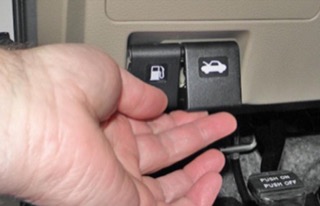Secondary Hood Latch Failure in the 5th Generation Altima
- The 2013-2018 Altima is in constant danger of the hood suddenly flying open while driving.
- The system's secondary latch is subject to corrosion and fails to keep secure the hood when the primary latch fails or is inadvertenly left open.
- Nissan slowly spread 4 recalls over 6 years before deciding to replace the entire latch assembly in 2020.

A defective design and mechanical failure are to blame for hoods suddenly flying open while driving the 2013-2018 Altima. The problem is responsible for 16 accidents and presumably a lot more code brown moments.
Nissan first recalled the latches in 2014. Over the next six years they slowly expanded the scope and accepted more blame as the problem continued happening.
Why Altima Hoods Fly Open ∞
Most modern hood latches have three components.
- A hood release switch inside the car.
- A main latch which is controlled by the release switch. When this latch is opened the hood will "pop" open and provide access to...
- A safety latch that needs to manually be opened at the front of the car. This latch keeps the hood shut in case the main latch fails or is accidentally left opened.
The Altima's main latch isn't the problem. When the hood is properly shut there's little to no risk of it suddenly flying open and smacking you in the windshield.
The problem has to do with the design of the release switch, and the reliability of the safety latch.
A failure of design ∞
There are two interior release switches inside the 2013-2018 Altima.

One opens the hood, the other opens the fuel door. For some unexplicable reason they are both the same size, color, and placed right next to one another below the driver's eye level.
This makes it incredibly easy to to inadvertently "pop the hood" when you're trying to refuel the car. And if the primary latch isn't reset, that's when owners are finding out the hard way that their safety latch has failed.
And a mechanical breakdown ∞
According to Nissan, the safety latch can stick in the disengaged position due to years of build-up and corrosion.
Nissan likes to blame the problem on a manufacturing error with the latch supplier. It appears plating may not have been applied properly to the latch assembly and can cause a problem with paint sticking to the latch. That loose paint can then flake off and leave bare exposed metal, which is turn is subject to corrosion.
Over time, [corrosion] may create mechanical binding that could cause the secondary hood latch to remain in the open position if the hood is not properly closed.
A Slow Release of Recalls ∞
Nissan has very slowly and ineffectively addressed this problem with 4 recalls spread out over 6 years:
- November 2014 – The first hood latch recall covered more than 220,000 Altimas from the 2013 model year. If the latch moved freely after cleaning and lubrication, technicians were advised to bend the latch lever using an angled pry-bar. That's the sort of precision work you can count on always working.
- March 2015 – The second hood latch recall involved 625,000 Altimas and expanded to the 2013-2015 model years. Nissan claimed the anti-corrosion treatment that was applied to the latch assemblies by the supplier was faulty. Technicians were asked to apply rust treatment and white lithium grease to any moving latches, or replace the latch assembly. No prybar required.
- January 2016 – The third hood latch recall expanded previous recalls to 846,000 vehicles. This time instead of inspecting the latches, technicians were finally advised to just replace the latch assembly.
- June 2020 – The fourth hood latch recall expanded the previous recalls to nearly 1.9 million vehicles, including the entire 5th generation from the 2013-2018 model years.
What Nissan discovered between the 2014 and 2020 recall is that inspection, lubrication, and cleaning of the latches was inconsistent among its dealerships.
The fourth recall will finally replace the hood latch assemblies with new latches that have anti-corrosion coatings, something that should have been done years ago.
Fourth Times a Charm? ∞
A hood latch class-action was filed after the fourth recall was announced.
On the surface that might sounds counter-intuitive now that Nissan has pledged to replace the whole hood latch assemblies in all 2013-2018 Altimas. However, there are still some lingering questions about this problem:
- Why did it take six years and three failed recalls before a fourth recall to actually replace the defective part?
- Are the new latch assemblies functionaly different than the previous assemblies, or is Nissan relying on an anti-corrosion coating to keep the latches from sticking?
- What, if anything, can be done about the design failure of putting the hood latch release switch right next to the fuel door release switch?
Reimbursements For Previous Repairs ∞
Nissan Altima owners should request reimbursements if they paid for repairs to the hood latches. But many who've dealt with the automaker say their reimbursement offers have been "ridiculous and offensive" given the severity of the problem.
Lawsuits Regarding This Problem
Lawsuits about this problem have already been filed in court. Many times these are class-action suits that look to cover a group of owners in a particular area. Click on the lawsuit for more information and to see if you're eligible to receive any potential settlements.
Miller, et al., v. Nissan North America, Inc.
Case Filed
A Nissan Altima hood latch class action lawsuit alleges a recall hasn't done anything to fix the cars, and neither have three other hood latch recalls for Altima cars. The class action alleges 2013-2018 Altima drivers are in danger from hoods that suddenly fly open while driving, allegedly a problem Nissan doesn't know how to properly repair.
Generations Where This Problem Has Been Reported
This problem has popped up in the following Nissan generations.
Most years within a generation share the same parts and manufacturing process. You can also expect them to share the same problems. So while it may not be a problem in every year yet, it's worth looking out for.
5th Generation Altima
- Years
- 2013–2018
- Reliability
- 54th of 54
- PainRank™
- 59.71
- Complaints
- 1484

